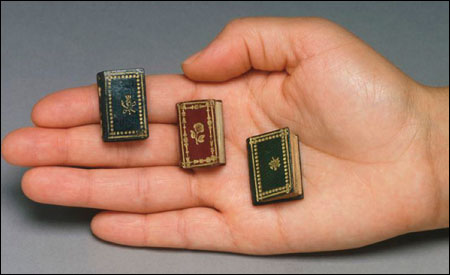New exhibit proves size doesn’t matter
Houghton Library to host pretty big exhibit of very little books

A miniature book is just that – a diminutive text, generally less than 3 inches tall. A few of these books can be read fairly easily, some with effort and eyestrain, and others only with high-powered magnification. Houghton Library’s upcoming exhibition “A Miniature Lesson in the History of the Book,” opening today (April 14), will feature approximately 300 of these tiny books from the collection of Julian I. Edison ’51, M.B.A. 1953.
Edison, a collector since his Harvard days and editor of the quarterly Miniature Book News, has built a large library of these tiny tomes, each of which could fit neatly in the palm of your hand. A few could fit on the tip of your finger – although if you dropped one, you’d be hard-pressed to find it again.
Miniature books have existed for centuries, and the items that Edison handpicked for the Houghton exhibition span 4,000 years. “The exhibition is a miniature history of the book,” explains William Stoneman, Florence Fearrington Librarian of Houghton Library. The oldest examples are small Babylonian cuneiform tablets that date from approximately 2300 B.C. One of the newer items is a five-millimeter square gold plaque from 2001 with all 180,000 words of the New Testament incised on it.
But many of the books are around the size range of small travel dictionaries, according to Hope Mayo, Philip Hofer Curator of Printing and Graphic Arts at Houghton. Edison’s selections for the exhibit include books printed before 1501, 20th century literature, religious texts, children’s books, propaganda, and almanacs. There’s even a miniature book about pacemakers, with an actual pacemaker inlaid in the cover. “Clearly an advertising effort on the part of the manufacturer of the pacemaker,” notes Mayo.
Publishers have not only experimented with the size of the book, but the size of the text, which can be minuscule. “In fact, some come packaged with their own magnifier,” says Mayo. “One little Bible has its own magnifier in a pocket built into the back cover. It magnifies the letters … some.”
Why publish a miniature book? For ease of transport, for novelty, but more often seemingly for the challenge. “Clearly the art is in how small can you make it,” adds Stoneman.
And there are no limitations on subject matter. “Anything is fair game if the printer wants to make a miniature book of it,” says Mayo. “There are miniature Dantes and miniature Bibles. It’s not about how you read them or why, but about if you can miniaturize a text and how small you can make it.”
So how small can you make them? Very small, apparently. A few of Edison’s books could compete for the title of smallest book in the world. And, indeed, it’s a rare Houghton exhibition that takes 300 volumes to fill its cases.
The exhibition, which runs Monday-Friday, 9 a.m.-5 p.m., through Sept. 2, marks the reopening of the newly renovated Edison and Newman Room. A gift from Edison, Bernard A. Edison ’49, M.B.A. ’51, and Andrew E. Newman ’66, M.B.A. ’68 enabled the library to refurbish the room’s infrastructure and to support future public programming and publications associated with exhibitions.




